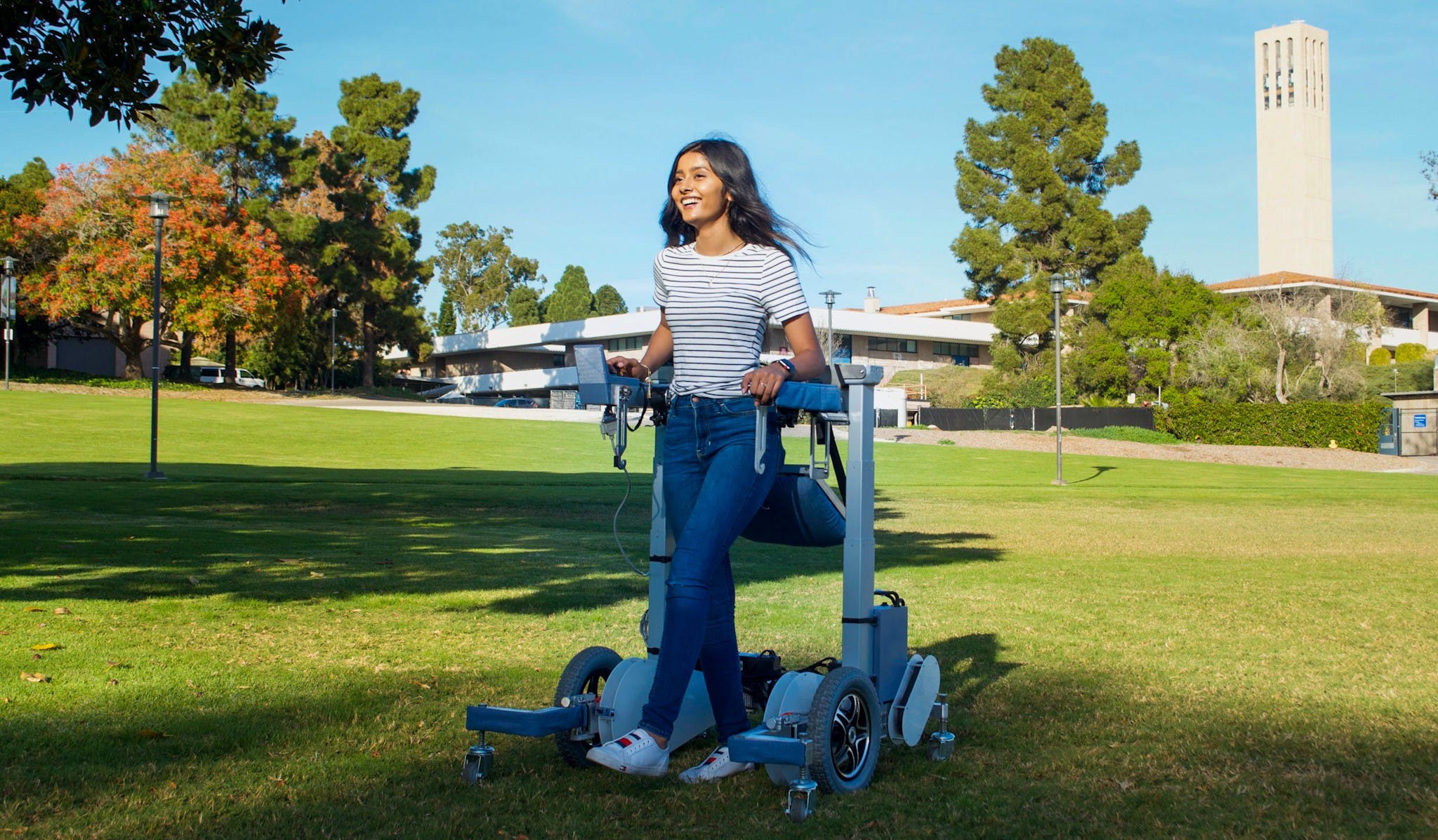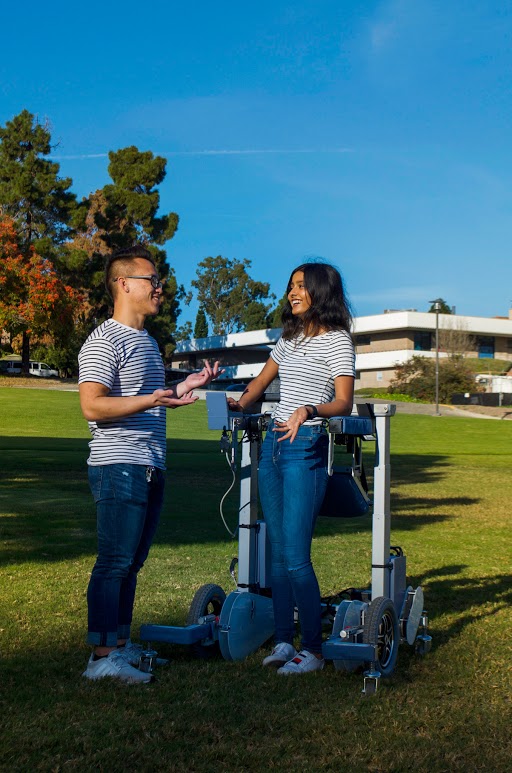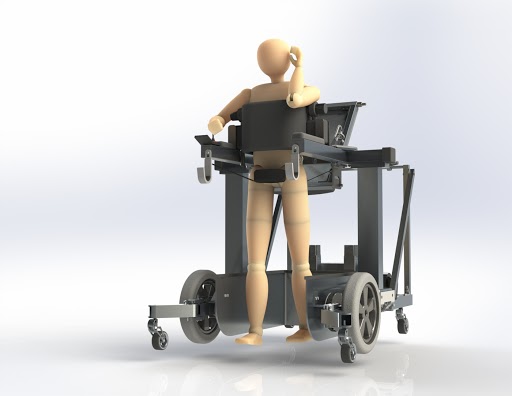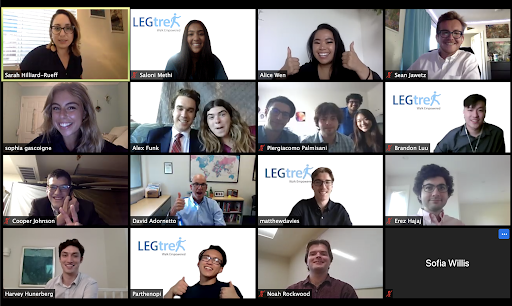
Each year, many young entrepreneurs spend months transforming an idea into a viable business plan in the UCSB New Venture Competition. Some of these NVC teams emerge with breakthrough technology that has the potential to change millions of lives and the dynamics of a particular industry. LegTrek is one of these teams.
LegTrek is a startup focused on designing assistive robotic devices to empower users with limited lower limb mobility. Current solutions are limited to a single mode of mobility, and cycling between these solutions requires a caregiver to transfer users out of their power chair and into a gait trainer, for example. The Lumi, LegTrek's pilot design, is seeking to change all of that.
Lumi is an assistive motorized gait trainer combined with a power chair. This device delivers empowerment and independence through the user's newfound ability to walk whenever they want without anyone else's help.
I recently got the chance to talk to the LegTrek team (Kevin Huynh-Tran – CEO, Alice Wen – COO, and Saloni Methi – CFO/CMO) about their journey from winning second place in the 2020 NVC to taking second place at the 2021 UCLA MedTech Conference demo track. The LegTrek team, all 2020 UCSB graduates, provided insight into their event prep strategy, the importance of team cohesion, and what it's like attempting to reach escape velocity with an idea that has the potential to do a lot of good.
Note: This interview has been edited for length and clarity.
How do you prepare for success at events like the UCLA MedTech Conference?
Kevin: Pitching is one of the more challenging things that we had to learn. We have to think about what is the overall objective. Sometimes it's more business-oriented and sometimes it's more technology-oriented, such as the case for the UCLA MedTech Demo Track. Then we have to determine the main takeaway for the audience. In the beginning, we tended to ramble on about every detail of the technology or our go-to-market strategy.
Shout out to the TMP program for teaching us how to prepare for pitching events. Through NVC and the TMP program (TMP 149), we learned how to clearly articulate our message into a five or seven-minute presentation; hopefully in a convincing manner. That's what we continue to do to this day. We try to make each presentation geared towards whatever we think the judges are seeking. And sometimes we're wrong.
Alice: We definitely anticipate all the questions coming from the investors. Saloni and I are not engineers, but we have weekly meetings with engineers to understand the technology, so we're able to answer the questions in such a way that our audience may understand it. And secondly, we practice our pitches a lot. We would spend a few hours on the weekends practicing our pitch. We are consistently evolving our pitch, presentation skills, and our pitch deck.
Saloni: We are also getting constant feedback from the judges. We don't just go to an event and then let it slide, we network. We ask judges for advice and feedback. It is not only about preparing before the event but also preparing for future events.
"Every step along the way in our company's trajectory, in one way or another, UCSB resources have been a tremendous contribution."
How do you prepare for Q&A sessions with investors?
Alice: I usually prepare for the questions beforehand by taking a step back from my perspective of the project and think like an investor. What do I care about? Market size, market strategy, financial projections? What about the technology? I'm not technical, so I'm going to ask you the most basic question that there is to ask, like, for example, does it fit in the hallway? How long does the battery last?
At UCLA Med Tech, there were a lot of lawyers, so one of the important things to us was intellectual property. It was funny because they didn't ask about the patent. It goes to show, even when you're preparing for it and you anticipate the questions, they may surprise you and not ask that question.
Saloni: We also look at the background of judges. If we know them beforehand, we see what they're interested in via LinkedIn or by getting suggestions from our mentors. It's a matter of being confident about your answer. Even if you don't know, if you are fully confident in your answer, that's a good sign for the judges.
Kevin: After you work on it for a long time, you generally do know the answer, or you know that you don't have the answer currently. As Alice said, we've pitched this many times. As a byproduct of shortening the pitch, we recognize the general trends of questions and points of confusion. And if it's something that we didn't prepare for, we are still always able to generate an answer.
What was your reaction to finding out that LegTrek was the youngest team in the demo track at UCLA MedTech?
 Alice: It was shocking, but we gave it our best shot! Everyone was a Ph.D. or MD, and it was very inspiring to us. Because, out of all these medical devices, being the youngest team demonstrated how far we have come despite how early we are. It motivates me to continue down this path. Running a startup isn't easy. Customer validation is not easy. For us to get that recognition was very motivating.
Alice: It was shocking, but we gave it our best shot! Everyone was a Ph.D. or MD, and it was very inspiring to us. Because, out of all these medical devices, being the youngest team demonstrated how far we have come despite how early we are. It motivates me to continue down this path. Running a startup isn't easy. Customer validation is not easy. For us to get that recognition was very motivating.
Saloni: Being the youngest team is scary. But it's also inspiring, and it's kind of fun to be one of the younger teams. I think we get that comment a lot when we're talking to the judges after events.
Kevin: It triggered a bit of imposter syndrome. I remember I was slightly intimidated by the doctors and their presentations; it was pretty much a Ph.D. thesis or dissertation. And all of these MDs whose prototypes are currently in a stage of operation are already using their stuff to perform surgeries. I was intimidated, but you have to leave all of that behind and perform.
One of your teammates took to social media to express her pride for LegTrek and the honor of getting second in the demo track, but also took the opportunity to point out a representation issue for females in medtech. Is that something that you experience in general?
Saloni: Even in the NVC, I think there were less than ten women that were competing. We were genuinely curious about how it is in the real world, like how a woman may not want the presentation roles. We are two females out of a team of five, but we always feel and act like the representation is equal. We don't feel like we are the women in the group. I want to give a shout-out to Ali Bauerlein from Inogen. She is one of the first C-suite people that we met, and she's from Santa Barbara. She is someone I look up to. It's nice to see women succeed in the C-suite environment.
Alice: I'm very optimistic about the future for women in medtech. In my graduate program, most of my medical device professors are women. They are not just females, but very young leading females in their field, like my professor, Kiana Aran. She is the Chief Strategy Officer at a biotech startup. That is very inspiring to me because she's paving the road.
My other medical device professor, Anna Hickerson, was the first professor that we talked to at NVC. I messaged her before I was a student at Keck Graduate Institute, and she pointed us in the direction of the Abilities Expo. Without her pointing us in the right direction, we wouldn't be where we are today. Not only that, but she introduced us to her network, which consists of renowned physical therapists.
What advice do you give to people looking for mentors?
Kevin: The mentors that we found through the NVC program are still very active in guiding us today. They include Remmert Laan, Charlie Pitman, and Ilan Ben-Yaacov, our capstone engineering advisor. Our advice for finding mentors is to look around and give everybody a chance. Try to be honest and engaged. That will be your compass for determining which relationships to continue.
Saloni: It goes both ways, we need to like the mentors, but they also need to like us and be willing to invest time in us. We try to be respectful of their time, they try to be respectful of our time, and we both get something out of it.

How have UCSB resources affected your trajectory as an emerging startup?
Saloni: Four out of five of us who were in the TMP 149 class are with the company today, which showed us how we could work as a team. That was a key factor because we didn't know we're going to move forward with the company until we got second place at NVC. We realized, “Oh, we work really well together!” We wouldn't have found each other if it wasn't for UCSB.
Kevin: I cannot over-stress how instrumental UCSB resources were to our current trajectory. It planted the seed for our company, and the project emerged from a capstone engineering project. We had access to a bunch of engineering resources and also a cohort of very talented engineers. The second way UCSB impacted us was by making connections with mentors. Without those mentors, I wouldn't have been pushed to continue beyond a simple engineering project. Throughout the TMP program and NVC, we had a ton of help determining which direction made the most sense for LegTrek if it were to be a company.
UCSB also connected us to funding opportunities. We participated in the G2 Accelerator and Goleta Entrepreneurial Magnet Program directly referred to us by Dave Adornetto, with whom we worked very closely throughout the TMP program. Every step along the way in our company's trajectory, in one way or another, UCSB resources have been a tremendous contribution.
Alice: The team was one of the biggest reasons after NVC that I chose to continue, because the team dynamic is spectacular. We all bring different insights and experiences to the table. And not only that, but we're willing to teach each other. The networking events are where you meet your people.

What piece of advice would you give to aspiring entrepreneurs at UCSB?
Kevin: I think about this often because some teams look to me for advice. I'm still evolving my answer, but I think what I've got so far is something akin to "just do it." Repeatedly take leaps of faith because there will always be obstacles and uncertainties that will convince you not to do it.
For example, you're unsure if people believe in your vision or whether the business makes sense, even though it's a fantastic idea. All of these concerns and worries can stop you in your tracks before you begin. There is no secret ingredient to getting to where we are, we just worked hard and did it. Hopefully, others see themselves in us and what we're hoping to achieve here.
Alice: From a female perspective, we have been told no our entire life. Entrepreneurship is not something that a lot of females pursue. As Kevin said, if you believe in your mission, it doesn't matter. You have to move forward. When we went to the Abilities Expo, a kid almost jumped out of his wheelchair to try to get onto our prototype. At that moment, it was clear how important the mission is.
Coming off of the podium at UCLA MedTech, what are LegTrek's plans for the next few years?
Kevin: We are focused on three key activities. The first would be to complete another prototype and be ready for clinical evaluation, feedback, and user testimonials. Secondly, we need to undergo another R&D phase to bring the technology to a market-ready state to apply for FDA clearance. All of that requires funding, so thirdly, we will be actively seeking funding through more pitch competitions, grant applications, and angel investors.